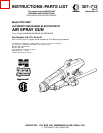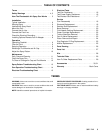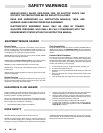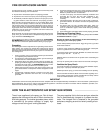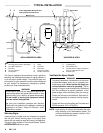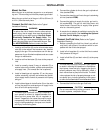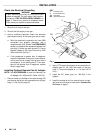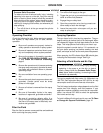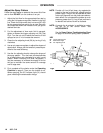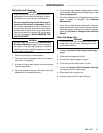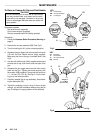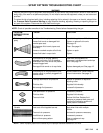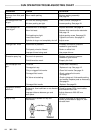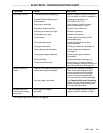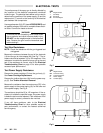
4
307-712
SAFETY
W
ARNINGS
SERIOUS BODILY INJURY, EXPLOSION, FIRE, OR ELECTRIC SHOCK CAN
OCCUR IF THE PRECAUTIONS BELOW ARE NOT FOLLOWED.
READ AND UNDERSTAND ALL INSTRUCTION MANUALS, TAGS, AND
WARNING LABELS BEFORE OPERATING EQUIPMENT.
ELECTROSTATIC EQUIPMENT SHALL ONLY BE USED BY TRAINED,
QUALIFIED PERSONNEL WHO SHALL BE FULLY CONVERSANT WITH THE
REQUIREMENTS STATED WITHIN THIS INSTRUCTION MANUAL.
EQUIPMENT MISUSE HAZARD
General
Safety
Any
misuse of the spray equipment or accessories, such as overpres
-
surizing,
modifying parts,
using incompatible chemicals and fluids, or us
-
ing
worn or damaged parts, can cause them to rupture and result in
seri
-
ous
bodily injury
, fire, explosion or property damage.
NEVER
point the spray gun at
anyone or at any part of the body
. NEVER
put
hand or fingers over the fluid nozzle.
ALWAYS
follow the
Pressure Relief Procedure
, at right, before cleaning
or
removing the fluid nozzle or servicing any system equipment.
NEVER try to stop or deflect leaks with your hand or body
.
NEVER
alter or modify any part of this equipment; doing so
could cause it
to
malfunction.
CHECK
all spray equipment regularly and repair or replace worn or dam
-
aged
parts immediately
.
System
Pressure
This
gun has a maximum working air and fluid pressure
of 7 bar (100 psi).
Never
exceed the maximum working pressure of the gun or any other
component or accessory used in the system.
Fluid
Compatibility
BE
SURE all fluids and solvents used
are chemically compatible with the
“Wetted
Parts” shown in the
TECHNICAL DA
TA.
Always read the fluid
and
solvent manufacturer
’
s literature before using the fluid or solvent in
this
gun.
Pressure
Relief Procedure
To
reduce
the risk of serious bodily injury
, including splashing in the eyes
or
on the skin, injury from moving parts or electric shock, always follow
this
procedure when shutting of
f the system, when checking or
servicing
any
part of the spray system, when installing, cleaning or changing fluid
nozzles,
and whenever you stop spraying.
1. T
urn of
f all the air to the gun except the cylinder (actuating) air
.
2. T
urn of
f the fluid supply to the gun.
3. Actuate
the gun
into a
grounded
metal waste container to relieve fluid
pressure.
4. Open
the pump
drain valve, having a waste container ready to catch
the
drainage.
5. Leave
the pump drain valve open until you
are ready to spray again.
HAZARDOUS
FLUID HAZARD
Improper
handling of hazardous fluids or inhaling vapors can cause ex
-
tremely
serious bodily injury
, even death, due to splashing in the eyes,
ingestion,
inhalation, or bodily contamination.
Be
sure you know what fluid you are pumping and its specific
hazards.
Observe
all precautions when
handling known or potentially hazardous
fluids,
including, but not limited to, the following.
1.
Store hazardous fluids in approved containers.
2. Dispose
of any waste fluid according to all Local,
State and Federal
regulations
pertaining to the disposal of hazardous wastes.
3. Read and follow the fluid and solvent manufacturer’s literature
regarding
the use of protective clothing and equipment such as
eye
protection,
respiratory protection, and gloves.
4.
Provide for the safe piping and disposal of all exhaust air
.
5. Provide proper ventilation in accordance with accepted industry
standards and governmental regulations. Refer to Ventilate the
Spray
Booth
, on page 6.
HOSE SAFETY
TIGHTEN
all fluid connections securely before each use.
NEVER
use a damaged hose. Before each use, check the entire hose
for
cuts, leaks,
abrasion,
bulging cover
, or damage or movement of the hose
couplings.
If any of
these conditions exist, replace the hose immediately
.
HANDLE
AND
ROUTE HOSES CAREFULL
Y
. Do not pull on hoses to
move
equipment. Do not use fluids or solvents which are not compatible
with
the inner tube and cover of the hose.



